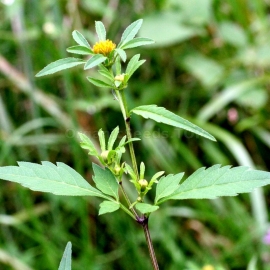





Organic Burr Marigold Seeds (Bidens Tripartita)
1.14 €
Burr marigold is little used as a medicine nowadays, but it was once esteemed for its styptic properties being used to quickly staunch blood flow - it was often used to treat uterine haemorrhage and conditions producing blood in the urine.
-
Organic Burr Marigold (Bidens Tripartita)
Burr marigold is little used as a medicine nowadays, but it was once esteemed for its styptic properties being used to quickly staunch blood flow - it was often used to treat uterine haemorrhage and conditions producing blood in the urine.
The whole plant is antiseptic, aperient, astringent, diuretic, emmenagogue, febrifuge, narcotic, sedative, styptic and sudorific. It is an excellent remedy for ruptured blood vessels and bleeding of any kind, and is of benefit to people with consumption. It is used internally to treat bladder and kidney problems, blood in the urine, uterine bleeding, ulcerative colitis and peptic ulcers.
Externally, it is used in the treatment of alopecia. It is usually combined with a carminative herb such as ginger when used to treat digestive tract ailments. The plant is harvested as it comes into flower and is dried for later use.
How to grow
Bidens is an annual. It grows easily from seed. If you do decide to plant it, be sure that it isn’t considered noxious in your area, first. Plant the seed 4 cm deep in moist soil in early spring. You can broadcast it or sow it in rows. Keep moist until it emerges. Its lacy leaves are attractive. It is used as a potherb in much of the world. And if you are using it for food, harvest the leaves when young, as a spring tonic food. It gets more astringent as it ages. But don’t make it a major part of your diet. The high silica content can lead to problems.
If you are growing it medicinally, remove the flowers as they appear to extend the harvest window, retard seed maturation, and encourage leaf production. You will be able to get several harvests of leaves before Fall, depending on your climate. Older leaves are more astringent and drying than young leaves. In my tincture I used a combination of both older and young leaves.
Bidens pilosa, also called Bidens leucantha, is the main species used for medicinal studies, but there are a number of other varieties in the Bidens genus that historical use and early studies suggest can also be used. The entire plant is medicinally active, including the roots. A lot of scientific studies have been done on the constituents of Bidens pilosa, identifying around 100 different plant chemicals so far. The most promising are the flavonoids, and the poly-acetylene compounds, having the broadest anti-microbial activity.
